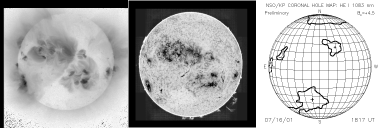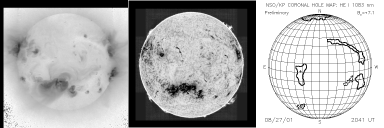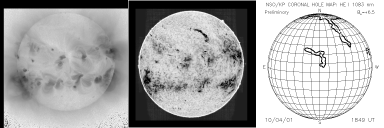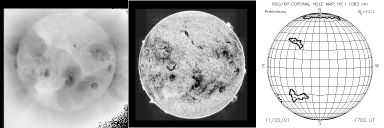
|

|

|

|
Coronal holes are easy to spot in soft X-ray images - they are almost absolutely dark (but see the innovative SXT eclipse observations by Hara, 1997) which suggest the existence of detectable soft X-ray emission within coronal holes. Coronal holes are also known (by correlation of Skylab soft X-ray images and solar-wind observations) to be the sources of high-speed streams of solar wind. Ergo, the magnetic field lines within these dark hole-like regions are open, in the sense that they support the solar wind. A particle can trace out the field line, in principle all the way from the photosphere to Andromeda.
However the observational appearance of a coronal hole and its theoretical significance for the solar wind are two distinct things, as neatly shown by the conflicting quotes in a recent major paper by Zhao et al. (1999). We just don't know from the images alone what field is open and what field is closed. Theoretically, we are faced with (a) variants of the odious but successful "source surface model", which unfortunately has an adjustable unknown parameter (the radius of the "source surface") that directly determines the very quantity that's desired (see my brief critique); or (b) a full-scale numerical simulation of the corona. The latter approach has many problems with unknown physics and ill-known input data.
The photosphere shows almost no sign distinguishing open from closed field lines. This is another reflection of the overwhelming power of the solar gas (dull) with respect to the fragility of the magnetic field (interesting) in the photosphere. In the corona it's the opposite - the field is powerful and the gas is fragile! We therefore need to look at the corona to see coronal holes. There are two rather different ways of imaging the corona on the disk of the Sun: direct X-ray or EUV observations of emission, or imaging of helium line absorption. The latter, using the He I 10830A line, is the standard used for Kitt Peak maps of coronal holes. See the example in our recent science nugget, or see others below, or look at the National Solar Observatory home page directly.
Who ya gonna trust?
So, which is better at seeing coronal holes? X-rays or He I 10830? We answer part of this question here by lining up several examples of images: X-ray, He I 10830, and coronal-hole maps. These are from four arbitrary times from Yohkoh observations in 2001 and show several coronal-hole morphologies: polar, polar extension, low-latitude isolated, and our new category, "skinny". The interested reader should pore briefly over these examples, looking of course for "striking similarities and intriguing discrepancies," and then compare notes with the section below.

|

|

|

|
In these layouts, the lighter regions correspond to coronal holes both in the X-ray and helium images. We have not tried to do exact time or scale matching here.
Observational inferences
Armed with these comparisons we can immediately answer the question above with a resounding "neither". The upper left X-ray image shows a skinny coronal hole running diagonally through the center of the disk. This is not seen in the helium image. On the other hand the X-ray image shows no sign of the north polar hole, a clear feature in helium. Other examples abound; for example the series at the bottom shows another diagonal "skinny coronal hole" in soft X-rays, but without a He I 10830 counterpart. We understand some of the reasons for these discrepancies:
Conclusions
This comparison has not brought us closer to understanding how the observational definition and the theoretical requirement ("dark" vs "open") can be reconciled. However the suggestion here is that the addition of the X-ray observations will change the coronal-hole areas by adding skinny features. These may have considerable magnetic flux, if the earlier science nugget, is in any way typical. So, the research suggested by this science nugget is to bite the bull by the horns and by golly add up the photospheric field, using different definitions of coronal-hole areas, and then see if we can see the same amount of magnetic flux - be it Maxwells or Webers - in interplanetary space.
H. Hudson (hudson@isass1.solar.isas.ac.jp)